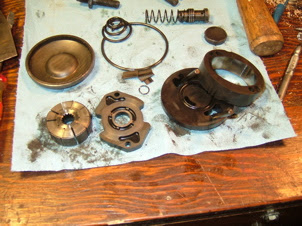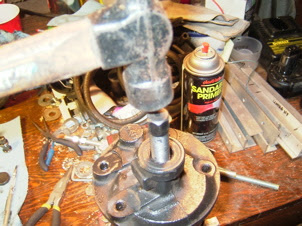If your Saginaw power steering pump is no longer working well or is leaking, save about $50 and rebuild it yourself. Here's a DIY guide on how to rebuild your PS pump.
These pumps are found in one of myriad older cars from the 70's and 80's: Buicks, Cadillacs, Chevrolets, Pontiacs, Oldsmobiles, GMCs, Volvos, Saabs, Chryslers, AMCs, Jeeps.
Tools Required
You need some basic mechanical skills, a little time, and either this $15 rebuild kit P/N 7910 or this $12 seal kit P/N 7918 (below). You can get these from various auto parts stores. Other brands are available.
Note: if your shaft bushing is worn, make sure you get a kit with the shaft bushing. Otherwise, the Powercraft 7918 seal kit is cheapest.
 |
Powercraft P/N 7918 power steering repair kit |
You'll need at least some of these tools:
- Impact wrench for removing mounting studs and fittings
- Combination wrenches for reinstall to prevent stripping studs
- Thin screwdrivers for prying
- A nail, scribe or punch, you'll see why
- The red box to the left is the kit for removing the PS pulley.
- Hammer for tapping out the shaft
- A seal puller tool will also help.
Reservoir Disassembly
 |
| #1, #2 are mounting studs, #3 is the pressure fitting |
Refer to the photo above. To begin disassembly, use an electric or air impact wrench with a long socket on #1 and #2, the mounting studs. They attach the case to the internal PS mechanism.
For #3 above, remove the fitting (probably did this already when you took out the pump) and use a 1" socket on the fitting to remove it. Be careful because there is a spring-loaded pressure valve that could pop out (below).
 |
| Spring-loaded pressure valve |
Use a power steering pump pulley remover/installer kit (available for borrowing or purchase from AutoZone, O'Reilly, etc., or purchase from Harbor Freight) I don't have any pictures of how to use this tool as they may vary. You can also have your local auto parts store remove the pulley for you.
Now place the pump in the vise (below). There is a flat spot on the snout casting, so clamp onto that.
 |
| Pump in vise on snout flat spots |
Use a rubber mallet and tap off the cover. Remove the magnet and clean off all the metal flakes from it (below).
 |
| Magnet inside the reservoir traps metal particles |
Power Steering Pump Disassembly
Next, you'll need to remove the lock ring that holds the pressure plate in place. There's a hole at the bottom of the PS casting through which you can insert a nail or similar object to force the lock ring out. You can then pry it out.
 |
| Lock ring removal; use access hole in casting |
 |
| Lock ring removal, another viewpoint |
If it helps, you may have to press down on the pressure plate while doing the above.
 |
| Press down on pressure plate while removing lock ring. |
Here are the parts that you've taken out so far. The lock ring, pressure plate, spring that holds the pressure plate against the lock ring, magnet, and pressure relief valve.
 |
Left, pressure plate; center, lock ring, pressure plate spring,
Top left: stud, top right: pressure valve and spring, magnet |
Inside, you'll see the pump assembly held in with a couple pins. The assembly is made up of a front and rear cover, sandwiching the eccentric housing and the vane and rotor assembly.
IMPORTANT NOTE BEFORE YOU REMOVE ANYTHING ELSE: Find the arrows on the eccentric housing, and note whether they are positioned at the front or the back of the power steering pump. You can install the housing in the wrong way.
If you do, when you reinstall in your vehicle, you will find it extremely hard to turn the steering wheel--the pump is actually fighting against you instead of assisting you. Ask me how I know!
There are many little steel vanes that slide in and out of slots on the rotor. First, remove the small lock ring on the pump shaft holding this assembly in. And, when you tip the pump upside down to tap out this assembly be careful you don't lose any parts. When you're done you'll have a bigger pile of parts.
 |
| Disassembly of Power Steering Pump section |
Finally you'll need to tap the shaft (below) from the front.
 |
| Tap out shaft |
You'll have this pile of parts, which now includes the pump shaft and lock ring.
 |
| Power steering pump parts now including shaft |
Finally everything is disassembled. Now it's time to replace all the remaining seals and reassemble.
Power Steering Rebuild
 |
| Remove PS front seal with seal removal tool or screwdriver |
Now, remove the front seal. You can also drive out the shaft bushing and replace that.
Replace the o-ring on the rear pressure regulator fitting (below).
 |
| Replace pressure regulator o-ring |
Clean the pump mechanism parts: the vanes, rotor, and rest of the assembly. Might as well oil them with ATF (or PS fluid) and reassemble them into the case with the lock pins.
Once again, make sure the direction of rotation is correct.
Replace the large o-ring around the pump housing, and the two small and one medium o-ring on the back face (below).
 |
| Add caption |
PS Pump Reassembly
Reassembly is essentially the reverse of disassembly. Reassemble the pump mechanism into the reservoir, reinstall the studs, pressure valve, and fitting, etc. Reinstall the PS pump onto the vehicle, reinstall the pressure hose and return hose, fill the reservoir, and give it a try.
If all goes well, it won't leak, and your power steering assist will be like new once again. Congratulations, you did it!
Basic Troubleshooting Tips
If it does leak, particularly around the large seal between the pump and reservoir, you might consider finding a different case at the junkyard and trying once more. That happened to me. The second time it worked great. Again if the power steering is fighting you and it's really hard to turn the wheel, you reversed the rotation of the pump eccentric housing. Time to do it all over again.
Even if you fail once or twice, in the long run, as you do this a few more times over the life of this and other vehicles, it'll get easier and you won't have to keep spending big bucks on rebuilt pumps.


















Any idea how to press out that shaft bushing?
ReplyDeleteThank you for this enlightening experience. I've gone to the technician for the fixing of my power steering pump but after all it's still the same. I took the courage to do it myself also and so I disassembled clean it and re-assembled it again. I thought all is well for am quiet sure I returned it properly but still the pressure is so weak and the wheel is hard to turn. Maybe I should know more of the details on what signs or marks to be observed when assembling the parts. Thank you if you could bear to give more guide on how to do it again.
ReplyDeleteJimmy, look for arrows on the eccentric housing showing the direction of rotation. Yours is surely reversed. Just flip it over.
DeleteJimmy, look for arrows on the eccentric housing showing the direction of rotation. Yours is surely reversed. Just flip it over.
DeleteThank you very much. I'm not so keen on the marks and how it turns, maybe that's the very thing I haven't discover yet. I will try again to check next week, am getting fond of it. I really want to learn before it will ultimately be replaced.
DeleteWhat year and model number is this pump and reservoir out of.
ReplyDeleteThis particular one I probably bought in a parts store. The article lists years and manufacturer vehicles you can find these in.
Delete